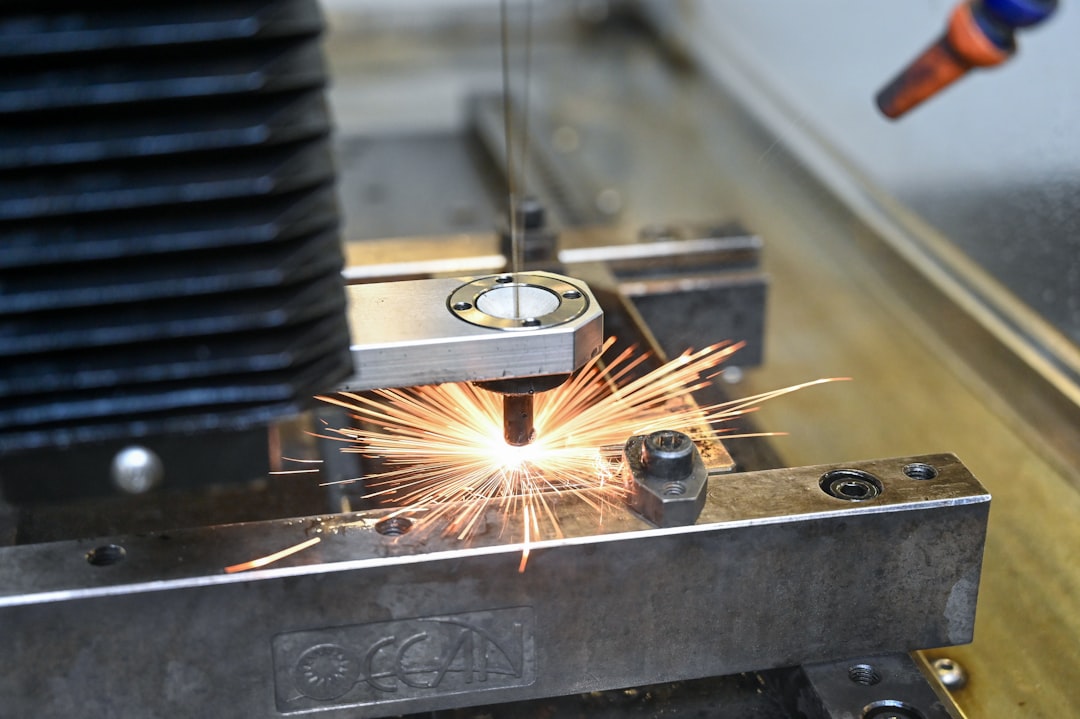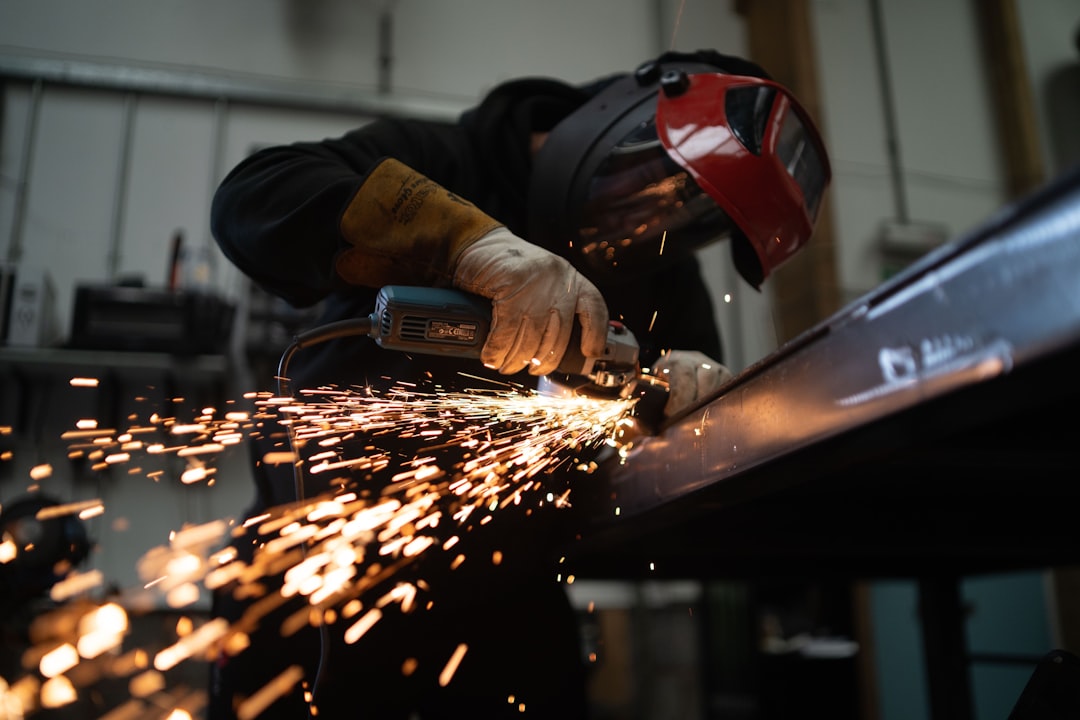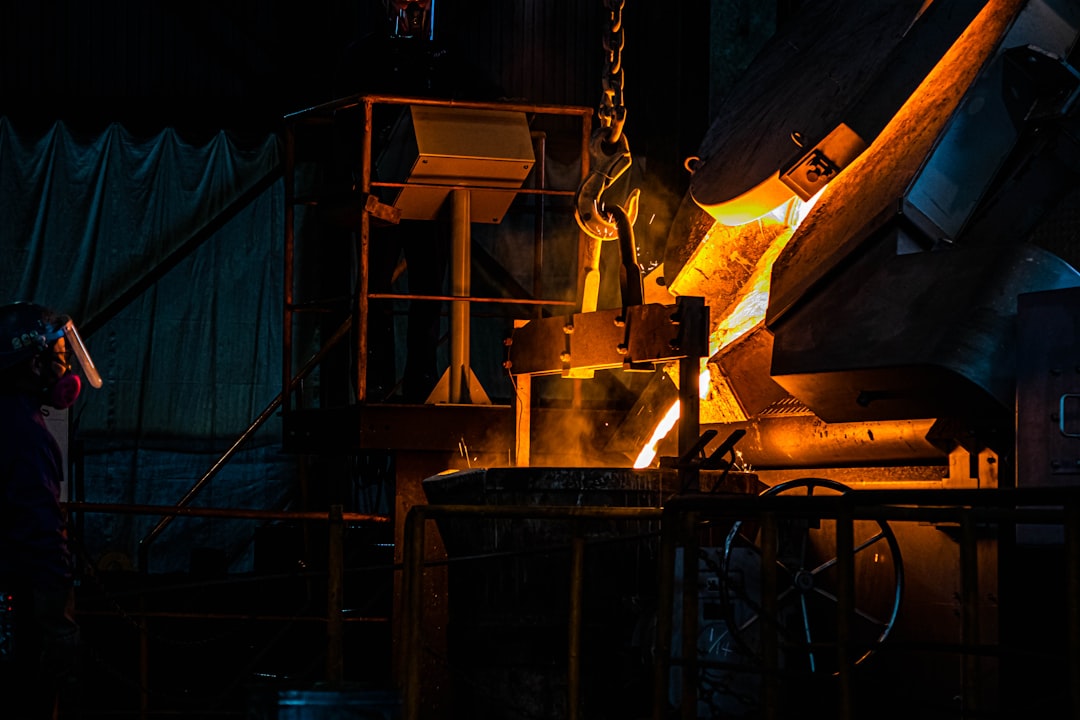

Engage prospects with a scan and streamline customer engagement with FREE QR code marketing tools by Sona – no strings attached!
Create a Free QR CodeFree consultation

No commitment

Engage prospects with a scan and streamline customer engagement with FREE QR code marketing tools by Sona – no strings attached!
Create a Free QR CodeFree consultation

No commitment
Today’s digitally driven landscape challenges metal fabrication companies to modernize how they connect with customers, partners, and prospects. QR codes are an essential tool for bridging the physical-to-digital gap, offering a fast, frictionless way to direct stakeholders from tangible touchpoints like brochures, signage, and equipment to actionable online destinations. For businesses specializing in the metal fabrication process, QR codes unlock new opportunities to educate buyers, showcase services, gather leads, and streamline workflows without requiring specialized apps or complex infrastructure.
As demand grows for custom and industrial metal fabrication solutions, there is an increasing need for efficient, trackable engagement strategies. Too often, metal fabrication enterprises lose high-value prospects because offline interactions are never captured in CRM systems or sales processes. QR codes turn every equipment brochure, job site sign, or delivered part into a potential tracked lead, closing the gap where interest might otherwise go unrecognized.
By enabling offline-to-online access, QR codes help metal fabrication companies promote services, distribute product information, empower sales representatives, and collect feedback on job sites or factory floors. This empowers growth marketers and decision-makers to capture every engagement, attribute results, and optimize outreach across every part of the customer journey. As more buying research happens without direct form fills, using QR code scans as The Essential Guide to Intent Data prevents valuable prospects from slipping through the cracks.

QR codes bridge the gap between physical materials and digital content, making it possible for metal fabrication companies to transform analog workflows, reduce friction, and deliver more value throughout every touchpoint. When a plant manager, buyer, or field technician can transition from a printed surface to a digital experience with a single scan, you dramatically reduce the friction that stalls projects and sales.
Many organizations face a persistent challenge: valuable leads and engagement signals are lost when workers, prospects, or partners interact only with physical assets or paper forms. For example, a project manager may review a printed brochure at a job site and intend to request a quote at a later date, but without a seamless handoff to digital, that interest often goes unrecognized and untracked. Replacing analog handoffs like clipboards, sign-in sheets, and static brochures with QR-enabled flows ensures every signal is captured and routed where it can drive action.
Here’s how to drive success:
End-to-end automation and visibility ensure your team avoids missed opportunities, connecting each engagement signal, from inquiry to delivery, with scalable follow-up and clear attribution. Modern platforms like Sona QR support the entire lifecycle: creation, deployment, tracking, and integrations that sync scan data into your CRM so revenue teams can respond quickly and appropriately.

Metal fabrication companies regularly contend with limited visibility into who is interacting with their physical marketing materials, job sites, or compliance documents. In an industry marked by complex buying groups, multiple decision-makers, and extended purchase timelines, a lack of insight into offline engagement means that potentially valuable leads or purchase intent can remain hidden until it is too late to convert. QR codes turn each physical touchpoint into a measurable digital entry point, creating a connected journey from the shop floor to the sales funnel.
Beyond marketing, QR codes are operational accelerators. They make it easy to push dynamic content to the field, adjust documentation on the fly, and reduce the load on support teams. When a customer or contractor can scan for the latest welding certifications or part specs, you avoid the costly miscommunications that happen when PDFs and binders are outdated.
QR codes address this challenge by:
QR-enabled workflows not only replace manual processes but also ensure that valuable intent data feeds into modern tracking and follow-up processes. The result is a more responsive buyer experience and an internally aligned team that knows which accounts are warming up and why.
QR codes adapt to a variety of metal fabrication applications where incomplete or outdated information can slow down operations or limit engagement. Traditional static brochures offer limited analytics and quickly go out of date, while QR destinations can be versioned and updated to reflect your latest capabilities, lead times, and certifications.
Dynamic QR codes with trackable destinations keep assets current and their usage measured, solving the challenge of outdated data and missed touchpoints. With Sona QR, you can create, manage, and update all of these formats in a single dashboard while preserving scan history and performance metrics.

Growth in metal fabrication depends on identifying high-value opportunities early in the buyer journey, even when initial interest comes through anonymous, offline interactions. Many companies struggle because interactions at job sites, on equipment, or at events are not captured in any measurable way. QR codes convert these invisible moments into data and next steps.
Think in terms of where your brand lives in the physical world. Every surface that already attracts attention can become a gateway to deeper engagement. By pairing QR codes with role-relevant CTAs and destinations, you can capture intent from project managers, plant supervisors, procurement teams, and OEM partners.
Opportunities arise wherever your target audience interacts with your brand offline, but only if those actions are linked to digital engagement:
By mapping the buyer journey and integrating QR-driven intent signals, metal fabrication companies maximize both initial outreach and long-term account development. The cumulative data clarifies which industries, roles, and channels are most responsive, which informs smarter planning for your next campaign.

Industry professionals report that engagement signals from demo content, compliance resources, or on-site documentation are often missed if there is no mechanism to capture and respond to offline behaviors. QR codes add that missing link, ensuring that interest is recorded and routed to the right teams in real time.
Below are high-impact use cases that pair naturally with everyday fabrication workflows. Each one transforms a paper-based or static experience into a living funnel entry point that tells you who is engaging, on what topic, and with what urgency.
Across these deployments, engagement tracking ensures that every signal, from a sales inquiry to a deep content review, is actionable rather than anonymous. Dynamic codes also give you the flexibility to swap landing pages as projects evolve, maintaining relevance at every stage.
For many metal fabrication businesses, traditional lead capture misses high-intent accounts that do not immediately request a quote. QR scans add nuance to your data by associating actions with topics, locations, and roles. With this context, you can retarget buyers based on what they care about and where they are in the journey.
Audience segmentation and retargeting via QR code scan data allows you to tailor outreach without guessing. You can differentiate between a plant maintenance supervisor scanning SOPs, a procurement manager reviewing volume pricing, and a project engineer downloading design tolerances. Each behavior warrants a different next step.
With Sona QR, each code becomes a smart entry point into your funnel. You can orchestrate segments that reflect real behavior, not assumptions, and you can notify sales when a target account repeatedly scans high-value content like certifications or parts catalogs.
Metal fabrication marketing often spans a complex blend of print, in-person, and digital channels. These efforts can feel disjointed when engagement from physical assets is not tracked or attributed back to outcomes. QR codes unify this activity by making every medium measurable and by smoothing the transition to digital experiences designed for conversion.
A connected funnel should link every offline instance to an online action. Over time, this paints a clear picture of how people progress from curiosity to confidence to commitment. The analytics enable smarter spend allocation and faster experimentation with messaging and content.
Centralized campaign monitoring makes it possible to see which channels drive true ROI and ensures that no high-value interaction slips through the cracks due to untracked offline touchpoints. With Sona QR, you can manage codes across channels and connect scans to CRM records for attribution.
A disciplined rollout ensures QR codes deliver measurable value rather than becoming scattered experiments. Use the following steps to plan, build, and optimize campaigns that serve buyers, support operations, and generate revenue.
Treat this as a repeatable process. Each time you launch a new use case, document what worked and what did not, then feed those lessons into your next wave. Over a few cycles, you will have a playbook that new team members can follow with confidence.
Start with a concrete, high-impact goal that translates to a digital action. Examples include streamlining RFQs from trade show traffic, digitizing warranty registration from delivery paperwork, enabling status tracking for active jobs, or capturing intent from equipment signage that would otherwise never reach your CRM.
Tie the use case to a business outcome, such as reduced time to quote, increased compliance documentation completion, lower support calls per delivery, or improved conversion from event meetings to pipeline. Clear targets focus your design and help you measure success.
Decide whether you need the flexibility and analytics of a dynamic code or the simplicity of a static code. Static codes are fine for fixed content, such as an unchanging equipment manual PDF. Dynamic codes are best for destinations that require updates, tagging, and tracking. They also unlock retargeting and A/B testing without reprinting.
In most revenue-oriented scenarios, dynamic codes pay off quickly because you can adjust the destination as you learn. Sona QR supports both types, with dynamic controls that preserve historical data even as you iterate on content.
Design for scannability in real industrial conditions. Use high contrast, adequate quiet zones, and sizes that remain readable from a safe distance. Add branded frames and a benefit-driven CTA, such as Scan for weld certs or Scan to request a site visit. Anticipate glare from metal surfaces, curved housings, and protective covers, and adjust placement accordingly.
Test across devices, distances, angles, and lighting. Validate performance after lamination, powder coating, or exposure to oils and dust. The best-looking code is useless if it fails under real conditions, so treat field testing as a required step before full deployment.
Place codes where your audience already engages. Common placements include job site signage, equipment panels, product labels, direct mail to procurement, trade show booths, and delivery documents. For each placement, match the destination to the action the user is most likely to take in that context.
Roll out in phases to control quality. Start with a small batch in one plant or at one event, then expand once you confirm scan rates, page load speeds, and conversion flows are performing as expected.
Use a real-time dashboard to monitor scans by time, device type, and location, and map these to downstream conversions like form fills, scheduled calls, or content downloads. Watch behavior patterns such as repeat scans from the same company or multiple scans of high-value assets like spec sheets.
Iterate continuously. Test different CTAs, landing page layouts, or content offers. With Sona QR, you can A/B test destinations and sync results with your CRM, making it easy to identify which combinations produce the best outcomes for each audience segment.
A short post-mortem after each campaign will surface best practices you can standardize. Over time, you will refine a set of proven templates for events, job sites, and packaging that reliably contribute to pipeline and customer satisfaction.
A frequent frustration among industrial marketers is the inability to trace the true impact of offline engagements on pipeline growth. With QR codes, tracking does not end at the scan. Comprehensive solutions let you analyze how scan activity influences the customer journey, from the first interaction to a signed quote and repeat orders.
The analytics layer is where QR codes shift from convenience to strategy. By unifying scan data with website behavior, email engagement, and sales activity, you can tell a complete story about which physical assets and messages accelerate deals, which reduces guesswork and focuses your investments.
With improved visibility, metal fabrication companies can optimize spend, prove return on marketing and operational investments, and avoid letting valuable engagement signals languish in anonymity. Over time, this clarity elevates QR codes from tactical add-ons to core components of your performance engine.
The most successful QR programs are deliberate, measurable, and aligned with how buyers and operators actually work. The goal is to make scanning the obvious, fastest path to value for anyone interacting with your brand in the physical world.
Prioritize simplicity and clarity. A strong CTA that states exactly what the user will get drives far higher engagement than a vague instruction. Pair that with automation and you will reduce manual follow-up while creating a consistent experience across sites and teams.
As a creative deployment, place QR codes on job site fencing near the site office with messaging like Scan for metal package specs and delivery windows. This captures attention from contractors and project managers already involved, turning a once-anonymous audience into a prioritized list for follow-up.

Stories from the field illustrate how QR codes turn physical interactions into measurable outcomes. The common thread is a practical placement, a clear CTA, and a destination that delivers immediate value in context.
Use these ideas as starting points, then adapt them to your workflows, safety requirements, and audiences. The best executions feel native to the environment and remove steps from the tasks people already need to complete.
Across these examples, the formula is consistent: meet users where they are, provide instant value, and capture the signal for follow-up. With a platform like Sona QR, you can manage these campaigns at scale and understand their cumulative impact on revenue.
Execution quality determines whether QR codes become a reliable growth lever or a short-lived experiment. Attention to environment, design, and process integration will help you avoid common mistakes and maximize ROI.
The physical realities of metal fabrication introduce unique constraints. Glare, abrasion, and distance can all impact scannability. Invest in durable materials, proper placement, and repeated testing. A code that performs perfectly in the office but fails on the shop floor will not generate the outcomes you expect.
Incorporating QR codes into the workflows and marketing strategies of metal fabrication companies unlocks transformative gains in engagement, operational efficiency, and real-time data capture. Too often, high-value prospects or intent signals are lost when companies rely solely on traditional marketing or incomplete digital analytics. Growth-focused organizations are now leveraging QR technology not only to reduce missed opportunities but also to empower buyers, enhance account personalization, and demonstrate the clear financial impact of data-driven outreach. Whether you are digitizing job site documentation, accelerating lead generation, or ensuring post-sale follow-up is timely and thorough, a strategic QR code approach has become essential for staying competitive in the evolving landscape of metal fabrication. With Sona QR and Sona.com, you can start creating QR codes for free, orchestrate campaigns across channels, and connect every scan to outcomes that matter.
QR codes have revolutionized metal fabrication companies by transforming how they enable access to critical information and streamline operations. From improving inventory management and equipment tracking to enhancing client communication and on-site safety protocols, QR codes deliver measurable efficiency and transparency. Imagine instantly connecting your team and customers to detailed project specs, maintenance records, or compliance data with a simple scan—eliminating delays and errors across the board.
With Sona QR, metal fabrication companies gain the power to create dynamic, trackable QR codes that can be updated anytime without costly reprints. This flexibility ensures your workflows stay current while providing real-time insights into usage patterns and engagement. By leveraging Sona QR, you turn everyday scans into actionable data that drives productivity, customer satisfaction, and operational excellence.
Start for free with Sona QR today and unlock the full potential of QR codes to streamline access and elevate your metal fabrication business.
The article does not list specific companies but suggests using local directories and platforms like Sona QR to find and connect with metal fabrication companies near you.
Choose a company that uses modern tools like QR codes for streamlined communication, provides trackable engagement, offers custom solutions, and demonstrates operational efficiency and transparency.
The article does not detail specific metal fabrication processes but focuses on how companies use QR codes to improve workflows, lead capture, and customer engagement.
Metal fabrication companies provide custom and industrial solutions, improve operational efficiency, enable real-time engagement through QR codes, and support streamlined workflows that reduce errors and accelerate project timelines.
Common applications include equipment maintenance, safety compliance, project updates, material traceability, packaging support, and providing technical documentation accessible via QR codes for enhanced operational support.
QR codes bridge offline physical assets with digital content, enabling quick access to product information, lead capture, feedback collection, and real-time updates, which helps track and convert high-value prospects.
Useful QR code formats include web links, vCards, digital forms, PDF downloads, Wi-Fi access, and SMS or email prompts, all of which can be dynamically updated and tracked for performance.
Effective placements include machinery and equipment, job site signage, trade show booths, product packaging, delivery documents, and direct mail to procurement teams to capture intent from relevant stakeholders.
They use centralized dashboards to monitor scans by time, location, and device type, integrate data with CRM systems, attribute leads to specific assets, and map buyer journeys to optimize marketing and sales efforts.
Design QR codes with high contrast, durable materials, appropriate size for safe scanning distances, clear call-to-actions, and test them under real conditions including glare and exposure to dust and oils.
QR codes convert physical touchpoints into trackable digital actions, enabling instant lead capture through forms, RFQs, or feedback that feed directly into CRM systems for timely follow-up.
QR codes reduce manual paperwork, prevent transcription errors, enable dynamic updates of documentation, streamline maintenance requests, and support self-service options for customers and contractors.
By embedding QR codes in print catalogs, event materials, direct mail, digital signage, and packaging inserts to unify offline and online engagement and track the effectiveness of each channel.
Avoid generic CTAs, ensure codes are durable and scannable in industrial conditions, keep linked content updated, measure beyond scan counts, and train teams to promote scanning effectively.
By assigning unique QR codes to assets, categorizing scans by buyer journey stage, tracking location and timing, and syncing scan data with CRM and ad platforms to tailor outreach based on real user behavior.
Use Sona QR's trackable codes to improve customer acquisition and engagement today.
Create Your FREE Trackable QR Code in SecondsJoin results-focused teams combining Sona Platform automation with advanced Google Ads strategies to scale lead generation

Connect your existing CRM

Free Account Enrichment

No setup fees
No commitment required

Free consultation

Get a custom Google Ads roadmap for your business






Launch campaigns that generate qualified leads in 30 days or less.
